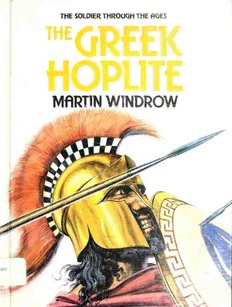
The Greek Hoplite PDF
Preview The Greek Hoplite
THE SOLDIER THROUGH THE fiGES WINDROW MARTIN THE SOLDIER THROUGH THE GREEK HOPL1TE Windrow Martin Illustrated by Tony Smith Franklin Watts London New York Toronto Sydney SAUSALITO PUBLIC LIEHARY UW . . .r A T.j~.J ©F First printed in Great Britain in 1985 by Franklin Watts Ltd 2a Golden Square 1 London W1 First published in the USA by Franklin Watts Inc. 387 Park Avenue South New York N.Y. 10016 First published in Australia by Franklin Watts Australia 1 Campbell Street Artarmon NSW 2064 UK ISBN: 0 86313 154 9 US ISBN: 0-531-03780-0 Library of Congress Catalog Card Number: 84-50020 Designed by James Marks Cover illustration by Gerry Embleton Printed in Belgium 1 Contents The cradle of civilization 4 A citizen's dutv 6 Kverv man an aHltlhllXevtLev 8 111CI11 CI11 1- i Military service 10 TXhllev hllovnll_/illtLev'sO eVvnluUliLn/lmllevnlltL 12 URaCtIItLllev XfVo/lr1m11aCItLilvo/n1 14 Battle tactics 16 Face to face across the spears 18 On the flanks ZU The Spartan legend 22 The wooden walls of Athens 24 Siege warfare 26 The Macedonian conquerors 28 Glossary 30 Index 32 The civilization which is called Classical Greece occupied the lands around the Aegean Sea in the 6th and 5th centuries BC. It was the earliest European civilization which left full written records for histor- ians, and its art, politics, culture and its armies were far more advanced than those found anywhere else in the West. Ancient Greece was never a single unified country. Because the countryside was mostly mountainous and wooded, there were few places where people could settle to farm good land. As a result, the towns that were built were far apart, and grew up into separate city-states, covering fairly small areas. The city-states were constantly quar- reling and forming alliances in rivalry with one another. This rivalry often led to open warfare, particularly between the armies of the city-states of Athens and Sparta. In the Classical period the infantryman was the backbone of all the armies of the different Greek states. He was called a hoplite, which means an armored man. The hoplite fought in an organized regiment of men, each ofwhom used the same weapons in the same way. He was given military training according to rules laid down by his government. A typical Greek heavy infantryman of the two centuries between 600 and 400bc. The Greek hoplite wore a crested bronze helmet. His chest and back were protected metal or and on his 4 The Greek hoplite was a disciplined fighter, obeying the orders ofhis officers, at a time when other warriors in Europe THRACE MACEDONIA fought as loose mobs of undisciplined indi- viduals. As far as we know, the Greek THESSALY hoplite was the first European who was not just a warrior but a soldier. He and his Thebes fellow fighters were the true ancestors of Athens today's armies. Corinth •Sparta The most important series of ruinous wars. In Greek city-states of the the end this so weakened Aegean Sea Rhodes 6th and 5th centuries are tnem that they were ripe shown on this map. The for invasion from the CRETE rivalry between Athens strong new kingdom of and Sparta led to a long Macedonia in the north. The Greek hoplite was not a full-time, paid soldier. Usually he earned his living as a farmer: rich men lived in the city and had stewards to run their estates, while poorer men worked their land themselves. All citizens, rich or poor, also played a part in running their city by voting in the city assembly. And, in times of war, rich and poor alike were expected to report for army service. Citizens had the time for these duties because almost everyone owned slaves. These might be foreign prisoners or poor people who had been sold into slavery when they could not pay their debts. There were many more slaves than citizens, and they did all heavy work. A rich man might own as many as 1,000 slaves, and even a poor peasant farmer had two or three. In Athens there was a third class of people, called metics. These were for- eigners living in the city. They were mostly businessmen and traders. They had few political rights, but they did serve in the army. In all, Athens is believed to have had about 40,000 citizens, plus their families; 20,000 metics, and their families; and about 180,000 slaves. •The three "faces" of city assembly regularly - an Athenian citizen: perhaps three times a soldier, voter and farmer. month - and to help run Every healthy male the city by electing citizen was expected to officials and passing serve in the army laws. whenever he was Most farmers did not needed. The Greeks have enough flat land to believed that if a man grow much grain. enjoyed the advantages Instead they grew grapes of living in a city, then he for wine, and olive: should be prepared to two crops that ma fight to defend it. Athens rich. Thev a The citizen was also grew many differ expected to attend the kinds of vegetable:
